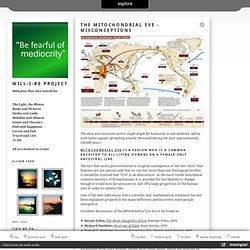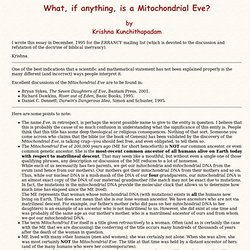

The Mitochondrial Eve - Misconceptions. The data are consistent with a single origin for humanity in sub-Saharan Africa, with homo sapiens spreading around the world during the past approximately 100,000 years.

Mitochondrial Eve is a person who is a common ancestor to all living humans on a female-only ancestral line. The fact that such a person existed is a logical consequence of the two facts: that humans are one species; and that no one has more than one (biological) mother. It should be stressed that “Eve” is an abstraction: as the most recent matrilineal common ancestor of living humans, it is possible for her identity to change, though it would now be necessary to kill off a large proportion of the human race in order to achieve this. One of the best indications that a scientific and mathematical statement has not been explained properly is the many different (and incorrect) ways people interpret it.
Excellent discussions of the Mitochondrial Eve are to be found in: Misconceptions Continue this process. Idealized Example. LearningLeads - Mapping Mitochondrial Eve. Issues such as Eve provide an opportunity to help secondary science students understand how science works in a meaningful context.

Eve is socio-scientific. At her core lies new science—not yet completely accepted—dealing with heredity and biological evolution and blending imperceptibly with social perspectives such as population growth. She demonstrates the impact of technology on our search for solutions, but more so the nature of science, as she begs solutions that require application of scientific criteria to critically assess claims, make decisions, and construct solid lines of argumentation related to the issue.
The MAP Teaching/Learning Framework (Figure 1) provides a structure for this type of exploration in accordance with National Science Education Standards (NRC, 1996), and Eve serves to demonstrate how the framework, a sequential approach consisting of three phases—motivate, assess, and propose—can apply to that issue and many others like it. No More Mrs. Shreeve, J. (1990).
What, if anything, is a Mitochondrial Eve? I wrote this essay in December, 1995 for the ERRANCY mailing list (which is devoted to the discussion and refutation of the doctrine of biblical inerrancy).

Krishna. One of the best indications that a scientific and mathematical statement has not been explained properly is the many different (and incorrect) ways people interpret it. Excellent discussions of the Mitochondrial Eve are to be found in: Bryan Sykes, The Seven Daughters of Eve, Bantam Press, 2001. Richard Dawkins, River out of Eden, Basic Books, 1995. Here are some points to note: The name Eve, in retrospect, is perhaps the worst possible name to give to the entity in question. As an exercise, try to eliminate just one phrase of the definition of the ME and see what happens.
I mentioned the Y-chromosome Adam (YcA for short) earlier in discussing patrilineal descent. A final note. Copyright © Krishna Kunchithapadam Last updated: Mon May 1 16:46:06 PDT 2000 Mirrored from: Tracing Ancestry with MtDNA. By Rick Groleau In 1987, three scientists announced in the journal Nature that they had found a common ancestor to us all, a woman who lived in Africa 200,000 years ago. She was given the name "Eve," which was great for capturing attention, though somewhat misleading, as the name at once brought to mind the biblical Eve, and with it the mistaken notion that the ancestor was the first of our species—the woman from whom all humankind descended.
The "Eve" in question was actually the most recent common ancestor through matrilineal descent of all humans living today. That is, all people alive today can trace some of their genetic heritage through their mothers back to this one woman. The scientists hypothesized this ancient woman's existence by looking within the cells of living people and analyzing short loops of genetic code known as mitochondrial DNA, or mtDNA for short. Nuclear DNA vs mitochondrial DNA When someone mentions human DNA, what do you think of?
Inheriting mtDNA Final note Notes.